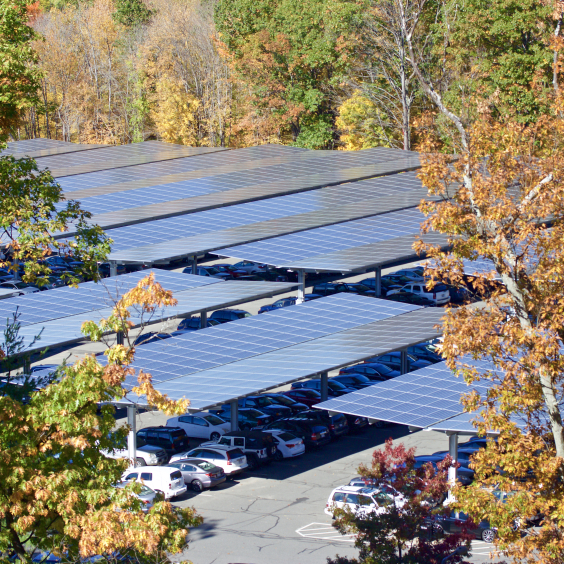Amherst’s Solar Assessment Shows Strong Preference For Canopy & Rooftop Solar

UMass is a leader in on-campus solar, with five parking canopy systems and five rooftop systems that produce sufficient renewable electricity to power 1,430 homes" Photo: umass.edu
The town of Amherst recently conducted a month-long community solar development survey. The comprehensive survey was designed to help identify community values as they relate to potential large scale solar development in the town.
The survey was developed and administered by a consultant, GZA GeoEnvironmental, Inc. Two town committees, the Energy and Climate Action Committee (ECAC) and the Solar Bylaw Working Group (SBWG), contributed to the development of the survey. Two in-person community workshops and input collected at an Engage Amherst webpage were also quantified in the results. Both groups had referred to the importance of gathering resident input to guide their committees’ mandates.
Last week, the consultant delivered the “Town of Amherst Solar Assessment Outreach Findings” at two online committee meetings. The first presentation was at the Energy And Climate Action Committee (ECAC) meeting held on Wednesday, April 26, and the second at the Solar Bylaw Working Group (SBWG) meeting on April 28.
The GZA GeoEnvironmental, Inc. slide presentation is located here.
The most notable results from the survey were:
• 90% of respondents want to see large scale solar installed on parking lot canopies and rooftops.
• Little support for large-scale industrial solar on forest land
• Little support for large-scale industrial solar on agricultural land or open space
• Some respondents showed interest in Dual-Use Agriculture/Solar.
• Most respondents support a strong solar bylaw that strictly regulates where solar can be constructed.
• Most respondents were aware of carbon emission targets and believe they are important.
After the presentation, the ECAC members did not have much to say about the long-awaited survey results, although some members expressed concerns about the survey demographics. They were concerned that survey respondents might not be representative of all Amherst residents. Two ECAC members, Steve Roof and Lori Golden, questioned the methodology of the survey. It is unclear how the data from the survey will be used by the ECAC in the future.
During the April 28 presentation to the SBWG questions from Jack Jemsek and Janet McGowan focused on interpreting the graphs because survey questions had different formats, and the meaning of percentages were not always clear. Jemsek was curious as to why there were various questions about water security and safety given that the Water Supply Protection Committee’s (WSPC) White Paper addressed this topic. Adrienne Dunk and others suggested that the White Paper from the WSPC might need to be more broadly distributed.
The survey’s evidence of broad support for canopies produced a robust discussion. Jemsek noted that the town does not have much asphalt where canopies might be constructed. He wondered if Amherst might lease parking lots from the college or university.
McGowan noted that the SBWG can make recommendations to the Town Council to encourage roof top solar as well as canopies through tax incentives to individuals and businesses.
Dunk and Town Sustainability Coordinator Stephanie Ciccarello emphasized there will be a report forthcoming with more detail and narrative.
Update: Final report dated May 18, 2023, available at amherstma.gov .

Sorry to be picayune about physics concepts, but unfortunately the photo caption
“UMass is a leader in on-campus solar, with five parking canopy systems and five rooftop systems that produce 10 million kilowatts of renewable electricity annually, the equivalent to powering 1,430 homes”
confuses energy and power: the power measures how quickly energy is delivered, while the energy integrates the power over time.
The MKS unit of power is the watt, 1 joule per second. Since the joule (the MKS unit for energy) is more obscure to most folks (it’s the kinetic energy of a kilogram mass moving at a meter per second: if you dropped a 100 gram chunk of cheddar from your kitchen counter, it would deliver about a joule of energy to your kitchen floor…), a more familiar unit of energy is the kilowatt hour (that’s 1000 watts times 3600 seconds or 3.6 million joules — a lot of cheese falling on the floor).
Eversource charges about a dime to generate a kilowatt hour of electrical energy (and another dime to deliver it to your house). The Sun also delivers energy to your house: over an hour on a sunny day, every square meter of your roof (or your driveway, or your lawn, or…) receives a kilowatt hour of solar energy (the average solar flux at the Earth’s surface is about 1 kilowatt per square meter).
A perfect solar panel could turn all of that into electrical energy, but nothing is perfect, and so you might need 10 panels to generate a kilowatt of electrical power, which (over a day) integrates to about 10 kilowatt hours of electrical energy, amounting to each person’s typical residential electrical usage — a dollar (plus another dollar for deliver) if you bought it from Eversource….
Hope that was informative — thanks for reading this far ?